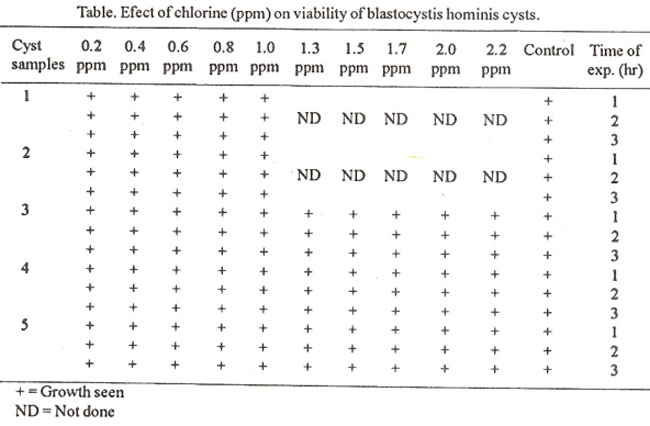Bilgiler > Resistance of Blastocystis Hominis Cysts to Chlorine
Resistance of Blastocystis Hominis Cysts to Chlorine

Resistance of Blastocystis Hominis Cysts to Chlorine
Pages with reference to book, From 178 To 179
Mehreen Zaki, Viqar Zaman ( Departments of Microbiology, Aga Khan University, Karachi. )
Nazar Ali Sheikh ( Departments of Maintenance, Aga khan University, Karachi. )
Introduction
Blastocystis hominis is an intestinal protozoan parasite1. Although the pathogenic potential of this organism remains controversial2,3, there is increasing evidence to suggest its involvement with human disease4-8. Infections due to blastocystis homims are quite common in the tropics and third world countries owing to the prevailing unsanitary conditions. Almost 50% of the random faecal samples from Aga Khan University Hospital, Karachi, grew the parasites in cultures9.
It is now well established that blastocystis hominis forms cysts1 which can easily be concentrated from faeces10, Blastocystis has also recently been isolated from sewage11. Although the mode of transmission of this parasite is not yet clear, infection can occur by the ingestion of food and water contaminated with cysts coming from faeces or sewage9.
Chlorine is one of the most widely used chemicals for disinfection of drinking water. Concentrations of 0.5-1.0 ppm (0.5-1.0 mg/litre) are effective for killing most vegetative bacteria and inactivating most viruses. Instances where over chlorination of 8-10 ppm is done, WHO recommends that the water then be dechlorinated to render it fit for human consumption12-14.
We undertook the present experiment to study the invitro effects of chlorine on the viability of blastocystis hominis cysts, as this has not been previously done.
Materials, Methods and Results
Varying concentrations of chlorine namely, 0.2,0.4,0.6, 0.8, 1.0, 1.3, 1.5, 1.7, 2.0 and 2,2 ppm were made in sterile distilled water using an electronic pocket colorimeter and DPD total chlorine indicator (HACH Colorimeter, P.O. Box 389, Loveland, Colorado 80539) according to the manufacturer’s instructions. Source of chlorine was a sodium hypochlorite (NaoCl) solution containing 13/14% of the elemental compound. Control tubes were constituted of sterile distilled water only. lx 106 cells from each of 5 individual cyst samples were inoculated into respective sets of both test and control tubes in triplicate. The tubes were mixed well and left to stand at room temperature for one, two and three hours respectively.
Following incubation, the tubes were spun at 2100 rpm for 10 minutes. Supematant was removed and the pellets containing cysts were resuspended in sterile distilled water and recentrifuged twice to remove all traces of chlorine. Washed sediments were inoculated into respective tubes of Jones media15 and incubated at 37°C. The culture tubes were examined daily upto 14 days.
Results, as presented in Table, show that chlorine in concentrations of upto 1.0 ppm had no cysticidal effect on all the 5 samples tested. Sample 2 when tested at 1.3 ppm proved to be resistant to the lethal effect of chlorine. Even at higher doses of upto 2.2 ppm chlorine was incapable of inactivating samples 3 through 5.
Comments
The availability of the cystic form of blastocystis hominis enabled us to perform this study. Unlike all other stages of the organism the cysts of blastocystis hominis are probably the only stage capable of surviving the external environment9. The present study shows that chlorine, in doses used forroutine disinfection of drinking water, has no effect on the viability of cysts obtained from faeces.
In this respect the finding is consistent with those of some other protozoan cysts14. The cysts of entamoeba can survive normal chlorination treatment and WHO recommends over chlorination with 8-10 ppm to effectively kill them. Giardialamblia cysts have been known to survive 0.5%(5000 ppm) chlorinated water for 2 to 3 days. In view of these findings food and water contaminated with cysts from faeces or sewage clearly present a possible source for transmission of this parasite.
http://www.jpma.org.pk/full_ar...article_id=4407
***